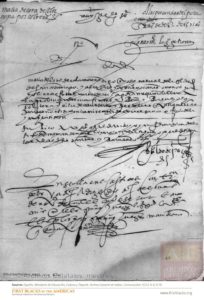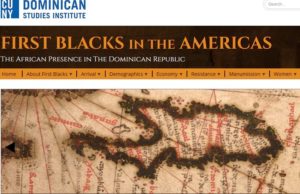Today’s students are commonly taught the early history of America’s colonization, along with the dark, disturbing details of how the transport and enslavement of millions of Africans built the nation into the superpower it is today.
But there’s an untold narrative of the nation’s early beginnings specifically pertaining to the fact that Blacks in the Americas during European colonization of the Americas actually arrived in La Española, today known as the Dominican Republic and Haiti. Now, a team of leaders from the Dominican Studies Institute at the City University of New York is working to shed light on this particular part of history that has remained largely ignored.
In early December, the Dominican Studies Institute launched the first bilingual educational website dedicated to the dissemination of the history of the first Black African occupants of La Española titled “First Blacks in the Americas,” or “Los primeros negros en las Américas.” The academic website features over 380 pages of manuscripts covering the years from 1497 to 1613, along with 79 pages of transcriptions (both in English and Spanish), 291 bibliographic entries and 131 glossary definitions.
Moreover, the informational site contains a number of historical images, maps, summaries and links to other scholarly online sources on Black culture for users to peruse.
Anthony Stevens-Acevedo, assistant director of the CUNY Dominican Studies Institute, told Atlanta Black Star that the first-of-its kind website is very important in terms of preserving the historical memory of the Dominican Republic for the sake of Dominican Americans and the international community at large. Through the site, he said the institute hopes to provide a deeper understanding of the DR’s cultural heritage, especially the Afro-Dominican aspect of it.
“We think it’s important mainly because it happens to be a period of the Black diaspora and a place of the Black diaspora in general that has been quite neglected in terms of the scholarly attention,” Stevens-Acevedo said, emphasizing that the site would actively serve to fill that void of missing historical information.
But how can we be sure of the history surrounding the tiny island nation’s first Black African inhabitants if its narrative has remained untold for so long?
Through preserved documents from the late 15th century is how, according to Stevens-Acevedo. The assistant director said that what is today the Dominican Republic was the first place in the Americas where the Black African diaspora was understood as a phenomenon in recorded documents. Evidence of such is detailed in the pages of mauscripts obtained by the institute chronicling the first 100 years after European settlers arrived on the island nation and the enslavement of Black people began.
“We’re talking about written documents,” he explained. “Modern times, post-European colonization times for which there is a historical record. And despite that the record having been there in the archive for ages, very little attention has been given to it.”

Manuscript-038: Date: 1575, December 14. Seville, Spain. Theme: After serving for more than ten years to two female mistresses in Seville, Spain, a young female black slave born in Santo Domingo City was granted freedom by her second mistress and, a few years later, requested license to travel back to the Americas. Source: PARES, Portal de Archivos Españoles–Archivo General de Indias, Contratación 5222, N.4, R.70
Stevens-Acevedo went on to attribute the scholarly neglect of the early history of Blacks in La Española to the language barrier, noting that most scholars cannot read Spanish fluently. Moreover, the early history of the Dominican Republic has largely remained outside the radar of U.S. and international scholarship. The assistant director emphasized that, over time, more scholarly attention had been given to Spanish-speaking countries like Mexico and Cuba, which both have political and economic ties to America.
The First Blacks in America website is “driven by this sense of urgency in terms of the need to tell this story, to bring it forth, to let people know that there was this history of an early and continued Black presence in Dominican culture,” he said.
Having worked over the course of seven years to compile the large set of documents featured on the site, Stevens-Acevedo explained that the the goal is to raise collective awareness of the Black African culture of the island, while also preserving the nation’s cultural history. But he acknowledged that during the institute’s steady research, a number of offshoot projects also blossomed, causing the research team to put their main project on hold.
For instance, their early work on the First Blacks in America website led Acevedo and others at the CUNY Dominican Studies Institute to produce a monographic study on the history of an early Afro-Dominican man named Juan Rodriguez, who became the first non-native, Black settler in New York around 1613. The institute then dedicated an art exhibit to Rodriguez and the historical documents chronicling his life, which also are featured on the new website.
Sarah Aponte, chief librarian of the CUNY Dominican Institute, told ABS that the exhibit is now traveling across the world.
In addition to the Rodriguez study and exhibit, the institute also created a Spanish paleography online tool to teach users how to read script and decipher the four distinct handwriting styles from that era. The website features 70 sets of documents (many of which are several pages long) and over 300 pages of digitized transcripts and their English translations, but all that information is rendered useless if visitors are unable to decipher what they’re reading.
As the only institution in the U.S. devoted to studying, producing research and disseminating information about Dominicans, the CUNY Dominican Studies Institute and its First Blacks in America website are continually working to fill the void of missing historical information pertaining to the Creolization of the Dominican Republic and how it shaped the nation’s history going forward.
Stevens-Acevedo said the institute is looking to expand its research in the coming years to include the history of the French colonization of Haiti, which occurred many years after the Spanish settlement of La Española. But for now, leaders and researchers at the institute say they will remain focused on raising collective awareness of the little-known narrative of the Dominican Republic’s first Blacks.



